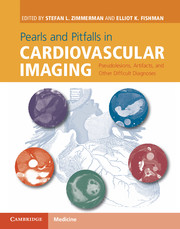 Pearls and Pitfalls in Cardiovascular Imaging
Pearls and Pitfalls in Cardiovascular Imaging from Section 1 - Cardiac pseudotumors and other challenging diagnoses
Published online by Cambridge University Press: 05 June 2015
Imaging description
A mass-like area of low signal intensity mimicking thrombus may be encountered in the setting of microvascular obstruction (MO) when cardiac MRI (CMR) is performed after acute myocardial infarction (MI). CMR is often used to assess viability after MI for prognosis and determining the need for possible revascularization. In the acute setting, large transmural MIs may demonstrate MO, which has been associated with poorer outcomes and adverse left venticular (LV) remodeling at follow-up imaging. MO is subendocardial in location and low in signal intensity on late gadolinium enhancement (LGE) images, characteristically surrounded by a zone of increased myocardial signal intensity due to LGE (Figure 5.1). MO represents a densely infarcted area of no-flow within the myocardium where gadolinium cannot reach due to severe micro- vascular damage. MO is recognized by its association with a wall motion abnormality, subendocardial decreased perfusion on dynamic post-contrast images, and a rim of delayed enhancement representing a zone of infarcted tissue with intact microvasculature that surrounds the infarct core with MO.
Importance
MO is important to recognize given the fact that it is associated with poorer outcomes after MI. MO must be correctly differentiated from thrombus, as this may require additional treatment such as anticoagulation therapy, which will expose the patient to additional bleeding risk in the inappropriate setting.
Typical clinical scenario
MO is encountered when viability MRI scans are performed in someone with recent MI. Differentiation of thrombus from MO is important as these patients with hypofunctioning myocardium in the setting of recent MI are at risk for thrombus due to blood stasis.
Differential diagnosis
Thrombus is the most important entity on the differential diagnosis of MO. The location of MO within the wall of the myocardium can help differentiate MO from thrombus. Myocardial location can be clarified by direct comparison of LGE and precontrast images (Figures 5.1, 5.2).
To save this book to your Kindle, first ensure [email protected] is added to your Approved Personal Document E-mail List under your Personal Document Settings on the Manage Your Content and Devices page of your Amazon account. Then enter the ‘name’ part of your Kindle email address below. Find out more about saving to your Kindle.
Note you can select to save to either the @free.kindle.com or @kindle.com variations. ‘@free.kindle.com’ emails are free but can only be saved to your device when it is connected to wi-fi. ‘@kindle.com’ emails can be delivered even when you are not connected to wi-fi, but note that service fees apply.
Find out more about the Kindle Personal Document Service.
To save content items to your account, please confirm that you agree to abide by our usage policies. If this is the first time you use this feature, you will be asked to authorise Cambridge Core to connect with your account. Find out more about saving content to Dropbox.
To save content items to your account, please confirm that you agree to abide by our usage policies. If this is the first time you use this feature, you will be asked to authorise Cambridge Core to connect with your account. Find out more about saving content to Google Drive.